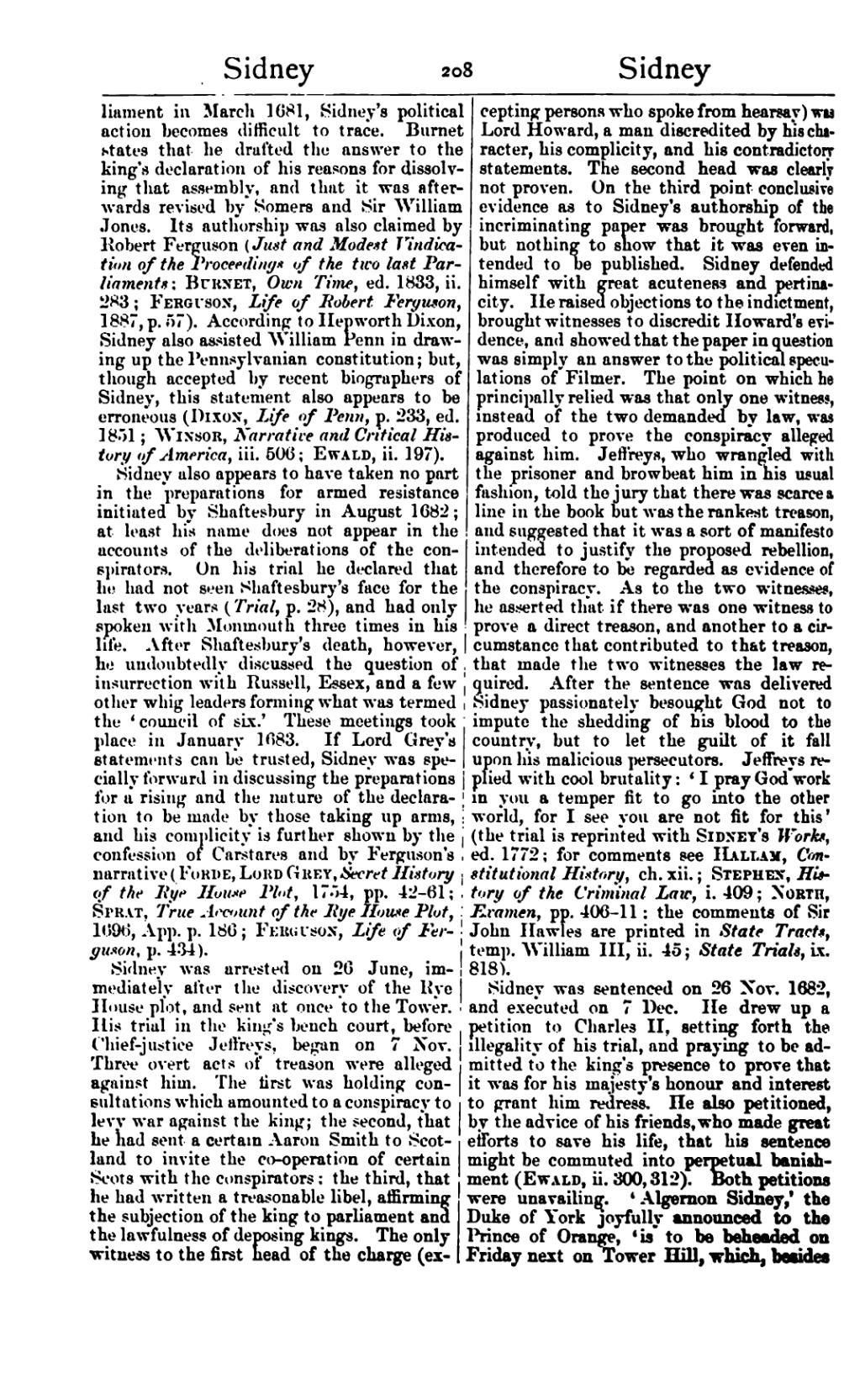liament in March 1681, Sidney's political action becomes difficult to trace. Burnet states that he drafted the answer to the king's declaration of his reasons for dissolving that assembly, and that it was afterwards revised by Somers and Sir William Jones. Its authorship was also claimed by Robert Ferguson (Just and Modest Vindication of the Proceedings of the two last Parliaments; Burnet, Own Time, ed. 1833, ii. 283; Ferguson, Life of Robert Ferguson, 1887, p. 57). According to Hepworth Dixon, Sidney also assisted William Penn in drawing up the Pennsylvanian constitution; but, though accepted by recent biographers of Sidney, this statement also appears to be erroneous (Dixon, Life of Penn, p. 233, ed. 1851; Winsor, Narrative and Critical History of America, iii. 506; Ewald, ii. 197).
Sidney also appears to have taken no part in the preparations for armed resistance initiated by Shaftesbury in August 1682; at least his name does not appear in the accounts of the deliberations of the conspirators. On his trial he declared that he had not seen Shaftesbury's face for the last two years (Trial, p. 28), and had only spoken with Monmouth three times in his life. After Shaftesbury's death, however, he undoubtedly discussed the question of insurrection with Russell, Essex, and a few other whig leaders forming what was termed the ‘council of six.’ These meetings took place in January 1683. If Lord Grey's statements can be trusted, Sidney was specially forward in discussing the preparations for a rising and the nature of the declaration to be made by those taking up arms, and his complicity is further shown by the confession of Carstares and by Ferguson's narrative (Forde, Lord Grey, Secret History of the Rye House Plot, 1754, pp. 42–61; Sprat, True Account of the Rye House Plot, 1696, App. p. 186; Ferguson, Life of Ferguson, p. 434).
Sidney was arrested on 26 June 1683, immediately after the discovery of the Rye House plot, and sent at once to the Tower. His trial in the king's bench court, before Chief-justice Jeffreys, began on 7 Nov. Three overt acts of treason were alleged against him. The first was holding consultations which amounted to a conspiracy to levy war against the king; the second, that he had sent a certain Aaron Smith to Scotland to invite the co-operation of certain Scots with the conspirators; the third, that he had written a treasonable libel, affirming the subjection of the king to parliament and the lawfulness of deposing kings. The only witness to the first head of the charge (excepting persons who spoke from hearsay) was Lord Howard, a man discredited by his character, his complicity, and his contradictory statements. The second head was clearly not proven. On the third point conclusive evidence as to Sidney's authorship of the incriminating paper was brought forward, but nothing to show that it was even intended to be published. Sidney defended himself with great acuteness and pertinacity. He raised objections to the indictment, brought witnesses to discredit Howard's evidence, and showed that the paper in question was simply an answer to the political speculations of Filmer. The point on which he principally relied was that only one witness, instead of the two demanded by law, was produced to prove the conspiracy alleged against him. Jeffreys, who wrangled with the prisoner and browbeat him in his usual fashion, told the jury that there was scarce a line in the book but was the rankest treason, and suggested that it was a sort of manifesto intended to justify the proposed rebellion, and therefore to be regarded as evidence of the conspiracy. As to the two witnesses, he asserted that if there was one witness to prove a direct treason, and another to a circumstance that contributed to that treason, that made the two witnesses the law required. After the sentence was delivered Sidney passionately besought God not to impute the shedding of his blood to the country, but to let the guilt of it fall upon his malicious persecutors. Jeffreys replied with cool brutality: ‘I pray God work in you a temper fit to go into the other world, for I see you are not fit for this’ (the trial is reprinted with Sidney's Works, ed. 1772; for comments see Hallam, Constitutional History, ch. xii.; Stephen, History of the Criminal Law, i. 409; North, Examen, pp. 406–11; the comments of Sir John Hawles are printed in State Tracts, temp. William III, ii. 45; State Trials, ix. 818).
Sidney was sentenced on 26 Nov. 1683, and executed on 7 Dec. He drew up a petition to Charles II, setting forth the illegality of his trial, and praying to be admitted to the king's presence to prove that it was for his majesty's honour and interest to grant him redress. He also petitioned, by the advice of his friends, who made great efforts to save his life, that his sentence might be commuted into perpetual banishment (Ewald, ii. 300, 312). Both petitions were unavailing. ‘Algernon Sidney,’ the Duke of York joyfully announced to the Prince of Orange, ‘is to be beheaded on Friday next on Tower Hill, which, besides
